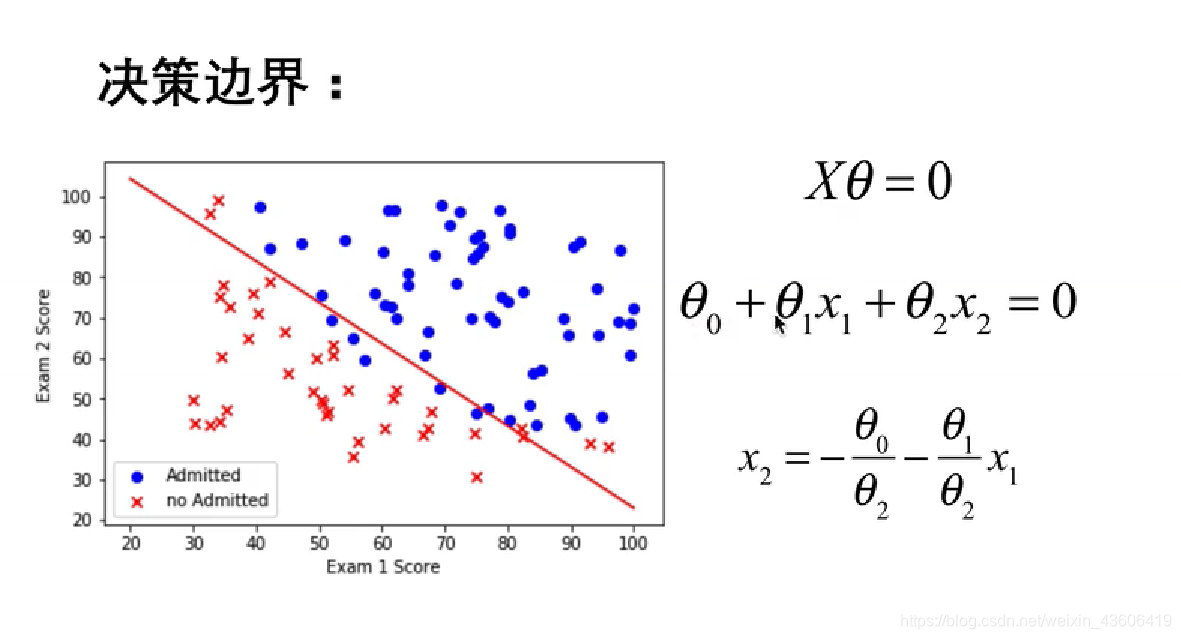逻辑回归1_线性可分问题
问题描述:根据学生的两门学生成绩,预测该学生是否会被大学录取
目录
1、加载数据集
2、可视化数据集
3、添加列
4、提取特征与标签
5、定义sigmoid函数
6、损失函数
7、梯度下降
8、预测
9、准确率
10、决策边界(补充知识点)
import numpy as np
import pandas as pd
import matplotlib.pyplot as plt
1、加载数据集
# 1、加载数据集
data = pd.read_csv('./ex2data1.txt', names=['score1','score2','possibility'])
data.head()
| score1 | score2 | possibility | |
|---|---|---|---|
| 0 | 34.623660 | 78.024693 | 0 |
| 1 | 30.286711 | 43.894998 | 0 |
| 2 | 35.847409 | 72.902198 | 0 |
| 3 | 60.182599 | 86.308552 | 1 |
| 4 | 79.032736 | 75.344376 | 1 |
2、可视化数据集
# 2、可视化数据集
fig, ax = plt.subplots()
ax.scatter(data[data['possibility']==0]['score1'], data[data['possibility']==0]['score2'],c='r', marker='x', label='y=0')
ax.scatter(data[data['possibility']==1]['score1'], data[data['possibility']==1]['score2'],c='b',marker='o', label='y=1')
ax.legend()
ax.set(xlabel='score1',
ylabel='score2')
plt.show()

3、添加列
# 3、添加列
data.insert(0,'ones',1)
data.head()
| ones | score1 | score2 | possibility | |
|---|---|---|---|---|
| 0 | 1 | 34.623660 | 78.024693 | 0 |
| 1 | 1 | 30.286711 | 43.894998 | 0 |
| 2 | 1 | 35.847409 | 72.902198 | 0 |
| 3 | 1 | 60.182599 | 86.308552 | 1 |
| 4 | 1 | 79.032736 | 75.344376 | 1 |
4、提取特征与标签
# 4、提取特征与标签
X = data.iloc[:, 0:-1].values
y = data.iloc[:, -1].values.reshape(-1, 1)
print(X.shape)
print(y.shape)
(100, 3)
(100, 1)
5、定义sigmoid函数
# 5、定义sigmoid函数
def sigmoid(a):
return 1 / (1 + np.exp(-a))
6、损失函数
# 6、损失函数
def cost_function(X, y, theta):
hx = sigmoid(X@theta)
cost = -np.sum(y * np.log(hx) + (1 - y) * np.log(1- hx)) / len(X)
return cost
# 初始化参数
theta = np.zeros((3,1))
cost_init = cost_function(X, y, theta)
cost_init
0.6931471805599453
7、梯度下降
# 7、梯度下降
def gradient_descent(X, y, theta, alpha, iters):
costs =[]
for i in range(iters):
hx = sigmoid(X@theta)
theta = theta -(alpha / len(X)) * X.T @ (hx - y)
cost = cost_function(X, y, theta)
costs.append(cost)
if i % 10000 == 0:
print(cost)
return theta,costs
iters = 200000
alpha = 0.004
theta_final,costs = gradient_descent(X,y,theta,alpha,iters)
1.9886538578930084
2.7066763807478127
5.159653459570274
1.3288041261254437
1.6525865746034032
0.334478044895226
0.8401579263488419
0.9593734096464135
0.3227041012186722
0.46007956427143226
0.5862147537785243
0.5563008562186095
0.5181653708713927
0.47602965884191434
0.43309711107262444
0.39138015073568366
0.3524418831806119
0.31772301939998754
0.2883949718298337
0.26496140669529517
theta_final
array([[-23.77445621],
[ 0.20684474],
[ 0.19996049]])
8、预测
# 8、预测
def predict(X,theta):
prob = sigmoid(X@theta)
return [1 if x >= 0.5 else 0 for x in prob]
prob = sigmoid(X@theta)
y_pred = [1 if x >= 0.5 else 0 for x in prob]
len(y_pred)
100
y_ = np.array(predict(X,theta_final)) # 把列表转换成一维数组
y_.shape
(100,)
y_pre = y_.reshape(len(y_),1) # 把一维数组 转换成 二维数组
y_pre.shape
(100, 1)
c = np.array([[1],[0]])
c
array([[1],
[0]])
d = np.array([[1],[1]])
c==d
array([[ True],
[False]])
acc_test = np.mean(c == d)
acc_test
0.5
9、准确率
# 9、准确率
acc = np.mean(y_pred == y)
acc
0.6
10、决策边界
补充知识点:
绘制的决策边界:
就是 hx = 0 的 那条直线,带入最后得到的最优参数。

# 10、决策边界
coef1 = - theta_final[0,0] / theta_final[2,0]
coef2 = - theta_final[1,0] / theta_final[2,0]
x = np.linspace(20,100,100)
f = coef1 + coef2 * x
fig,ax = plt.subplots()
ax.scatter(data[data['possibility']==0]['score1'],data[data['possibility']==0]['score2'],c='r',marker='x',label='y=0')
ax.scatter(data[data['possibility']==1]['score1'],data[data['possibility']==1]['score2'],c='b',marker='o',label='y=1')
ax.legend()
ax.set(xlabel='score1',
ylabel='score2')
ax.plot(x,f,c='g')
plt.show()
